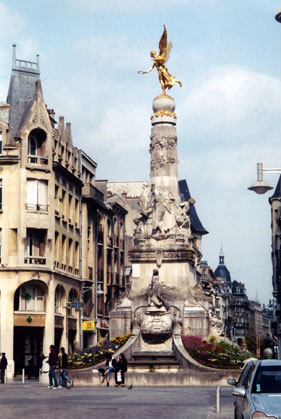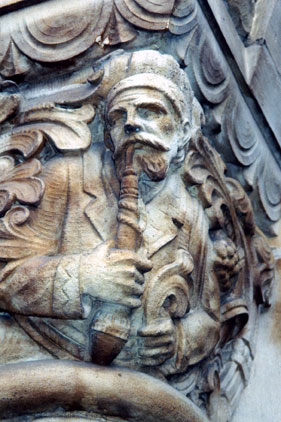|
The
Magnificent Cities of
Champagne and
Lorraine
Story and photos by Corinna Lothar
Nancy, France
 here's
nothing like Paris in the springtime. And from Paris, roads lead to
France's well known provinces and cities. Normandy, Brittany, Provence,
the Loire valley and the Cote d'Azur are well known to American visitors.
But there is an area of France less traveled, less crowded and well
worth a visit. Champagne and Lorraine are an area of lovely landscapes,
rolling hills, delicious food, fascinating history and marvelous cities. here's
nothing like Paris in the springtime. And from Paris, roads lead to
France's well known provinces and cities. Normandy, Brittany, Provence,
the Loire valley and the Cote d'Azur are well known to American visitors.
But there is an area of France less traveled, less crowded and well
worth a visit. Champagne and Lorraine are an area of lovely landscapes,
rolling hills, delicious food, fascinating history and marvelous cities.
RHEIMS
Rheims, the capital of Champagne, is less than an hour from Paris on the
fast TGV train. The wine, which takes its name from the region, was the
creation of the monk, Dom Perignon in the 17th century. It is aged in
bottles in the chalk tunnels, approximately 60 feet below street level,
dug by the Romans beneath the city. Visitors can visit the wineries and
sample the delicious result.
Rheims is France's art deco city. Badly damaged by German shells in
World War I, it was reconstructed in the art deco style after the war,
and many of the houses in the central part of town have beautiful art
deco facades. Waida, a pastry shop and tea salon in the central shopping
area offers a visitor not only delectable bread, pastries or chocolates,
but authentic art deco décor, in particular the exquisite wood
paneling with marquetry pictures of clocks showing various meal times
with the appropriate dishes.
The 13th century Cathedral of Our
Lady has particular significance in the history of France. The original
building was constructed on the site in 401, where Clovis, the first
king of the Franks and founder of the Merovingian dynasty, was baptized
around 496. It is in the cathedral in Rheims that the kings of France
- including Charles VII with the help of Joan of Arc - have been crowned.
The cathedral's stained glass windows dating from the 13th to the 20th
centuries, including a window dedicated to champagne, dazzle the eye;
the façade is a masterpiece of carving from the Middle Ages.
Next to the cathedral is the Tau Palace where the coronation banquets
were held. The palace is the former residence of the archbishops of
Rheims. The name dates from the mid-twelfth century and alludes to the
building's original layout in the shape of a "T," (Tau in
Greek), the form of the early cross. Today, the palace is a museum which
showcases, among other things, relics and objects used during the coronation
ceremonies.
Behind the cathedral is the art deco Carnegie Library, built in the
1920s, a gift of Andrew Carnegie. The lobby walls are decorated with
panels of mosaics inlaid with onyx and green marble. In the center is
a huge, colorful glass chandelier. The library specializes in books
about Rheims, and the elegant reading room is open to the public.
There are other, impressive churches in the city: the graceful St. James
Church, constructed at the end of the twelfth century with its contemporary
stained glass windows, is wedged between houses in a busy commercial
street; the basilica of St. Remi, dedicated to the city's patron saint
who baptized King Clovis, is the oldest church in Rheims; the tomb of
St. Remi is in the basilica. The former abbey next to the basilica houses
the St. Remi Museum where archaeological artifacts and 15th century
tapestries are displayed.
The city's Fine Arts Museum has an excellent collection of portraits
by Cranach, both the Elder and the Younger, collections of 17th century
paintings and 19th century French art, including paintings by Corot,
Millet, Monet and Vuillard.
Rheims was the seat of the World War II surrender by the Germans to
the Allies at 2:41 a.m. on May 7, 1945. In the War Room of Gen. Dwight
D. Eisenhower's headquarters, which occupied part of what, was the Rheims
technical college (now the Surrender Museum), Gen. Alfred Jodl, the
German chief of staff, signed the unconditional surrender. The room
where the signing took place is intact, down to the tiny white ashtrays
on the table. A photograph of the occasion is on display in the museum.
METZ
The French sometimes call it the "German"
city. Metz, one of the oldest cities in the world and the capital of
Lorraine, is a relatively unvisited French treasure. Settled by a Celtic
tribe in the 5th century B.C., it became a Gallo-Roman town after the
conquest of Gaul by Julius Caesar, and then the capital of Lotharingia.
It became French only in 1648 at the end of the Thirty Years' War. Metz
changed hands and nationality with the 19th and 20th century wars: German
in 1871; French in 1918; German in 1940; and finally French again in
1944. There remains a strong German architectural influence in part
of the city. The railroad station in particular is a superb example
of early twentieth century Germanic stone relief carving depicting activities
at the station.
What strikes a visitor to the city is the light. The medieval city is
built of beautiful yellow stone which turns almost golden in the sun.
Since Metz was built at the confluence of the Moselle and the Seille
rivers, the water reflects the sunlight as well. At night, the city
lights up its ancient buildings and monuments.
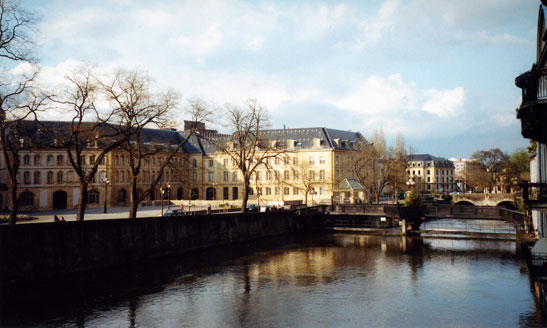
The Gothic St. Etienne Cathedral, like the cathedral in Rheims, is filled
with beautiful stained glass windows from the Gothic to modern. The
cathedral overlooks the central square on a hill above the Moselle.
In what was the bishop's palace on one side of the square is now a colorful
central market.
The church of St. Pierre aux Nonnains, dating from 400 A.D., is one
of the oldest churches in France. The frescoes in the 13th century Chapelle
des Templiers (Chapel of the Knights Templar) have been restored. The
city also boasts the oldest theatre in France still in use.
Metz has retained some Roman, medieval and 17th century ramparts. Of
the 19 medieval gates to the city, only two remain. The last relic of
the medieval fortifications is the Porte des Allemands (The Gate of
the Germans) with its two 13th century round towers and two 15th century
bastions.
Metz' Museum of the Golden Court incorporates Roman thermal baths. On
exhibit are Merovingian and medieval treasures, as well as paintings
by Corot and Delacroix.
For the past sixty years, the city has organized a Mirabelle Festival
at the end of August/beginning of September. The mirabelle is the delicious
little yellow plum used in Lorraine to make an eau de vie, liqueur,
jams, tarts and chutneys. Once or twice each month, a huge flea market
takes place on the outskirts of the city.
NANCY
As Rheims is to art deco, so Nancy is to art nouveau. A group of artists
and artisans led by Emile Galle created the School of Nancy at the beginning
of the 20th century and forged an alliance between art and industry.
Decoration in stained glass, wrought iron, sculpture, pottery, bookbinding,
architecture and furniture found their way into homes and businesses.
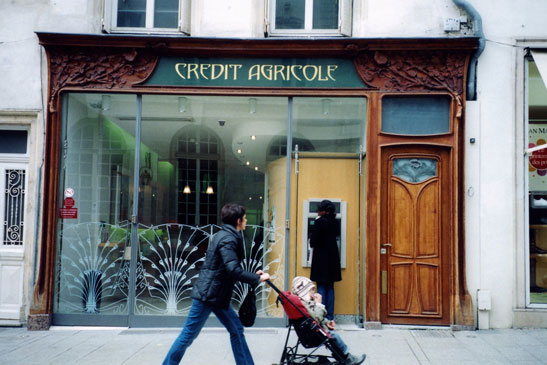
Nancy is filled with examples of art nouveau décor, one of the
best being Brasserie Excelsior. There is also a first rate art nouveau
museum presenting furniture, glass, jewelry and fabrics. The Tourist
Office has brochures on art nouveau walks.
Art nouveau represents Nancy's second "golden age." The first
relates to the 18th century when the Duke of Lorraine rebuilt the city
according to 18th century town-planning. Nancy's pride is the elegant,
recently renovated, 18th century Place Stanislas with its splendid mansions
surrounding the square and a set of gilded iron gates which front an
elaborate fountain. An arch of triumph leads from the Place Stanislas
to the adjoining lovely Place de la Carriere.
Nancy's Old Town is its medieval and Renaissance center. Not much is
left of the fortifications that protected the duke's palace (now the
Lorraine Museum) in the Old Town, except for the imposing 14th century
Craffe Gate which at one point was used as a prison. A small lantern
above the main gate dates to the 17th century; it contained a bell which
rang out the hours of the day, the beginning of the curfew and the time
of public executions. The New Town was founded by Duke Charles III at
the end of the 16th century south of the Old Town. Unlike the Old Town,
its streets are all at right angles.
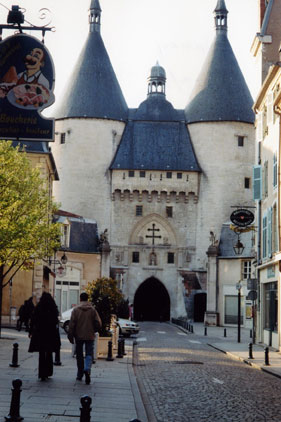 |
Nancy's Museum of Fine Arts has
an excellent collection of French paintings. The Folklore Museum is
housed in the former monastery next to the Church of the Cordeliers
where the dukes of Lorraine are buried in the crypt. The name "cordeliers"
comes from the Franciscan monks who wore a cord around their waists.
There are many other smaller towns in the region, where many gastronomic
specialties originated, such as madeleines, made famous by Marcel Proust,
and quiche Lorraine, which has become an American staple.
In the town of Bar-le-Duc, where the splendid Upper Town Renaissance
district has been restored, a local enterprise makes the "caviar"
that neither Victor Hugo nor Alfred Hitchcock could resist. Its red
and white currant jam, made by individually seeding each currant with
a goose feather, is 65 percent sugar and a 3-ounce jar sells for $62.
The village of Baccarat is home of the famous crystal. In Luneville,
St. Clement faience has been making beautiful dishes and table art for
250 years, including dishes for Marie Antoinette. Luneville is also
the town where macaroons were first introduced to France for the marriage
of Duke Charless III. The macaroons are now a specialty of the town
of Nancy.
The charming town of Verdun is home to the sugar coated almonds (dragees),
which the French give as a gift for special occasions. Verdun has been
making "la dragee" since an apothecary hit upon the idea of
coating an almond with layers of sugar and honey in 1220.
Verdun is forever etched in history for the terrible battles that took
place there during World War One. The remnants of that war - battlefields,
monuments, trenches and cemeteries can be visited throughout the area.
This year being the 90th anniversary of the Armistice, there are commemorations
and celebrations throughout the region.
And just a few miles further east lays Alsace with its foie gras, delicious
white wines and magnificent cities of Colmar and Strasbourg.
Accommodations:
Hostellerie du Coq Hardi is a charming hotel in the
center of Verdun with an excellent restaurant. Tel. 33 329 86 3636,
www.coq-hardi.com.
The Chateau des Monthairons in Dieue-sur-Meuse is a
beautiful small chateau in a large verdant park. The hotel and restaurant
are family owned and run; rooms are tastefully and comfortably furnished;
the kitchen is first rate; and the location is perfect for touring the
area. Tel. 33 329 87 7855, www.chateaudesmonthairons.fr
Information on Champagne and Lorraine
www.tourisme-en-champagne.com
www.ot-nancy.fr
www.tourisme-meuse.com
|
















